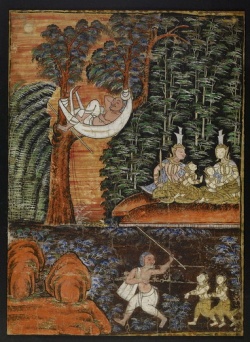Candimā
1. Candimā, Candimasa, Canda.-The name of the devaputta whose abode (vimāna) is the moon (Canda), sometimes also called Candima. The moon is forty-nine leagues in diameter and appears in the world at the wish of the ābhassara Brahmas, who are the first inhabitants of the earth, hence its name (amhākam chandam ñatvā viya utthito, tasmā cando hotū ti) (VibhA.519; PsA.253).
Candimā is also included among the Cātummahārājika devas because he lives in their world (E.g., Mahāniddesa Cty. 108). There are other devas besides Canda who dwell in the moon (D.ii.269).
According to the Bilārikosiya Jātaka (J.iv.63, 69), Sāriputta, having once given alms, was born as Canda, while in the Sudhābhojana Jātaka (J.v.382, 412) it is Moggallāna who was so born. The moon cannot move in the sky without the permission of Candimā, and he can stop its movement at will (E.g., DhA.ii.143, 146; iii.97).
It is said that once, when Candimā was seized by Rāhu Asurinda, he invoked the Buddha in a verse and the Buddha asked Rāhu to set him at liberty, which request was granted (S.i.50). The deva Candimasa who is mentioned (S.i.51) as visiting the Buddha is probably identical with Candimā. The moon was worshipped when children were desired (E.g., J.iv.1).
The Sasa Jātaka (No.513) gives details of the story of how, as a result of the Bodhisatta's sacrifice when born as a hare, Sakka painted the figure of a hare on the moon, which sign will be seen throughout this kappa (J.i.172).
2. Candimā.-One of the descendants of Okkāka. Mhv.ii.13; Dpv.iii.42.
